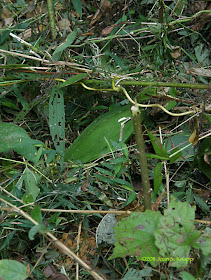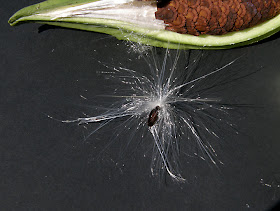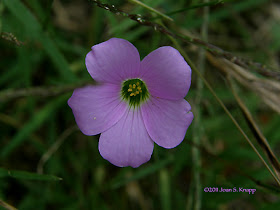 Piedmont National Wildlife Refuge - Pond 2A. October 8th, 2011.Click on the image to enlarge
Piedmont National Wildlife Refuge - Pond 2A. October 8th, 2011.Click on the image to enlarge
September 25th, 2011. We’ve been following some asclpeias and matalea vines in a local wildlife management area. Unfortunately, hunting season has arrived. One of the preparations that the wildlife management folk make for the hunting season is to mow the roadsides and some meadows to allow hunters access. Mowing also lessens the chance that careless hunters, and others, will accidentally set the woods on fire, particularly since many areas are tinder-dry due to the drought we’ve endured for the last couple of years. We keep our fingers crossed that the areas we frequent won’t be mowed before plants go to seed but... Sometime between September 10th and September 25th, they mowed.

*****
 It looks neat but…
It looks neat but… We’d been following this Asclepias viridiflora (Green Comet Milkweed) plant since May or so when we first found it.
We’d been following this Asclepias viridiflora (Green Comet Milkweed) plant since May or so when we first found it.
 Watching it bloom without developing seed pods until, finally...
Watching it bloom without developing seed pods until, finally...
 it developed a couple of pretty pods.
it developed a couple of pretty pods.
 This was all that was left of the plant. We hunted around and…
This was all that was left of the plant. We hunted around and…
 found the remains of just one pod.
found the remains of just one pod.
 Closer inspection showed that the mower blade had neatly sliced the pod and sheared the seeds from the silk. We only found one seed still attached to the silk. Hopefully the mower blade threw some of the seeds back into the woods where they can grow, bloom and develop seeds out of danger or the mowers.
Closer inspection showed that the mower blade had neatly sliced the pod and sheared the seeds from the silk. We only found one seed still attached to the silk. Hopefully the mower blade threw some of the seeds back into the woods where they can grow, bloom and develop seeds out of danger or the mowers.
 The second group of plants we’d been watching were vines of Matelea gonocarpa (Angularfruit Milkvine) further down the road.
The second group of plants we’d been watching were vines of Matelea gonocarpa (Angularfruit Milkvine) further down the road.
 These vines had developed a few pods. We found a couple of pods lying on the ground under the vines. Only one had developed on a vine that had climbed up about a foot above the ground on another plant.
These vines had developed a few pods. We found a couple of pods lying on the ground under the vines. Only one had developed on a vine that had climbed up about a foot above the ground on another plant.
 This pod was sliced lengthwise and thrown several meters away.
This pod was sliced lengthwise and thrown several meters away.
 The pod had shriveled but was still slightly green
The pod had shriveled but was still slightly green
 The seeds and silk seemed to be mature and ready to be dispersed in the wind.
The seeds and silk seemed to be mature and ready to be dispersed in the wind.
 One pod was still attached to a vine that hadn’t been cut by the mower. Hopefully, it will develop to maturity
One pod was still attached to a vine that hadn’t been cut by the mower. Hopefully, it will develop to maturity
 Another pod had split so we cut it open further. A single seed with its silk lies beside the pod
Another pod had split so we cut it open further. A single seed with its silk lies beside the pod
 Within a few minutes the silk fibers spread and the seed was ready to float away in the breeze.
Within a few minutes the silk fibers spread and the seed was ready to float away in the breeze.
 The seeds arranged in the pod. The raised circular section in the middle of each seed is the actual seed. The ‘serrated’ margin on each seed certainly would help them to catch on vegetation as they blew in the wind.
The seeds arranged in the pod. The raised circular section in the middle of each seed is the actual seed. The ‘serrated’ margin on each seed certainly would help them to catch on vegetation as they blew in the wind.
Mowing roadsides is a necessary evil to help prevent forest fires and some plants pay the price. Hopefully, seeds from these plants survived and will develop into new plants.
Click on an image to view a larger image
Distribution:
- United States Department of Agriculture Plants Database: Asclepias viridiflora (Green Comet Milkweed)
- United States Department of Agriculture Plants Database: Matelea gonocarpa (Angularfruit Milkvine)
Identification resources:
- Southeastern Flora: Asclepias viridiflora (Green Comet Milkweed)
- Southeastern Flora: Matelea gonocarpa (Angularfruit Milkvine)
With a Black Rat Snake (Pantherophis obsoleta): that is. I like Black Rat Snakes. This is the fourth I’ve encountered this year. I think I’m starting to understand them and I like them.
We were driving down a road in Hancock County, Georgia, when W swerved, hit the breaks, whipped he truck into reverse can backed down the road. It was less than a mile from where we encountered the Timber Rattlesnake (Crotalus horridus) in July. In this case, I didn’t hesitate to hop out and walk up to it – slowly so as not to upset it more than it probably already was. But, it wasn’t like walking up to the rattlesnake. It was like approaching an old friend. If I picked up snakes, I would have picked this one up without hestitation.
 *****
***** *****
***** It had started out onto the road as we came by. We hadn’t hit it. By the time we backed up, it was in its classic ‘crinkle’ pose.
It had started out onto the road as we came by. We hadn’t hit it. By the time we backed up, it was in its classic ‘crinkle’ pose.
 A closer view of its head
A closer view of its head
 And, for some reason, I took a shot of its tail; it was just stretched out
And, for some reason, I took a shot of its tail; it was just stretched out
 After a while, the tell-tale tongue flick. I’d seen that at Fort Yargo State Park when I encountered one on the trail late one afternoon. The sign that it was thinking about leaving. Testing the air to see if it was safe to turn and leave. What do they detect - or not detect - that tells them it's safe to leave?
After a while, the tell-tale tongue flick. I’d seen that at Fort Yargo State Park when I encountered one on the trail late one afternoon. The sign that it was thinking about leaving. Testing the air to see if it was safe to turn and leave. What do they detect - or not detect - that tells them it's safe to leave?
 Then it turned to leave
Then it turned to leave
 Interestingly, it ‘pulled’ its tail up as it started to move off. I’d never noticed that before.
Interestingly, it ‘pulled’ its tail up as it started to move off. I’d never noticed that before.
 And off it went. Safely back into the brush.
And off it went. Safely back into the brush.
It seemed as if we had been photographing it for a long time, but when I looked at the time-stamp on the images, the entire encounter had lasted a total of just four minutes.
Click on an image to view a larger image
Identification resource:
- Savannah River Ecology Laboratory, Herpetology Program: Black Rat Snake (Pantherophis obsoleta; formerly Elaphe obsoleta)
Related posts:
- OK, Now I’m Getting A Complex: Black Rat Snake (Pantherophis obsolete) At Home
- Black Rat Snake (Pantherophis obsoleta): Broad River Wildlife Management Area, Wilkes County, Georgia
- Black Rat Snake: Another Close Encounter
- And There It Was… Black Rat Snake (Pantherophis obsoleta)
 Nothoscordum bivalve (False garlic) plants were blooming near Pond 1A.
Nothoscordum bivalve (False garlic) plants were blooming near Pond 1A.  A Liatris sp. I’ve come to the conclusion that this is probably Liatris aspera (Roughleaf or Tall Blazing Star). Again, any corrections are welcome
A Liatris sp. I’ve come to the conclusion that this is probably Liatris aspera (Roughleaf or Tall Blazing Star). Again, any corrections are welcome  Andropogon virginicus (Broomsedge) plants are just starting to produce seed.
Andropogon virginicus (Broomsedge) plants are just starting to produce seed.  Cornus florida (Flowering Dogwood) berries are starting to turn red.
Cornus florida (Flowering Dogwood) berries are starting to turn red.  Verbena rigida (Tuberous Vervain) flowers are still holding on but it won’t be long before they’re finished for the season.
Verbena rigida (Tuberous Vervain) flowers are still holding on but it won’t be long before they’re finished for the season.  Helianthus angustifolius (Narrow-leaf Sunflower). We saw just a couple of plants near Pond 2A.
Helianthus angustifolius (Narrow-leaf Sunflower). We saw just a couple of plants near Pond 2A.  Erianthus alopecuroides (Silver Plume Grass) is a favourite at this time of year. These seed heads are not ripe yet.
Erianthus alopecuroides (Silver Plume Grass) is a favourite at this time of year. These seed heads are not ripe yet. Just a silhouette of Adropogon glomeratus (Bushy Bluestem). This species is easy to identify by its bushy heads.
Just a silhouette of Adropogon glomeratus (Bushy Bluestem). This species is easy to identify by its bushy heads.  What is this? Helianthus sp. (Sunflower)? It was almost dark when we found this.
What is this? Helianthus sp. (Sunflower)? It was almost dark when we found this.















































